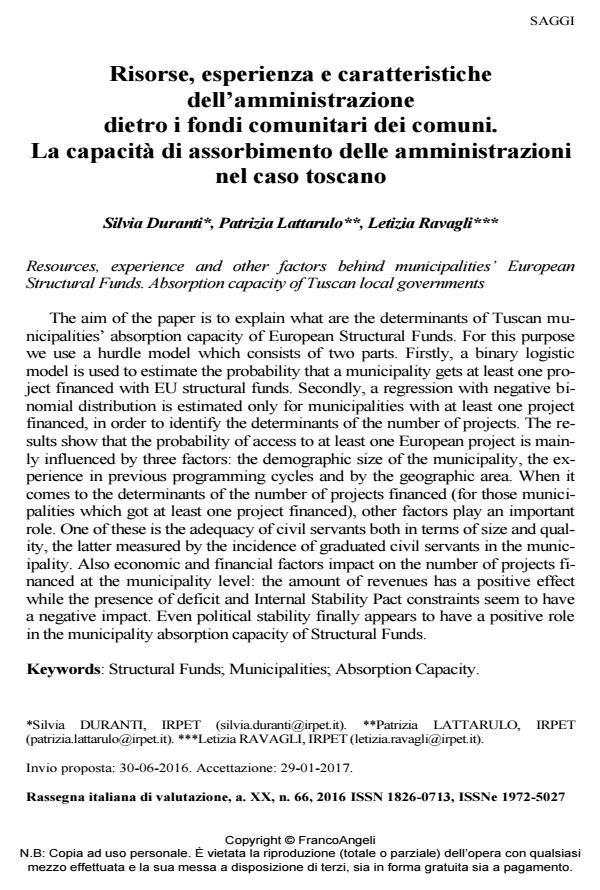Resources, experience and other factors behind municipalities’ European Structural Funds. Absorption capacity of Tuscan local governments
Journal title RIV Rassegna Italiana di Valutazione
Author/s Silvia Duranti, Patrizia Lattarulo, Letizia Ravagli
Publishing Year 2017 Issue 2016/66
Language Italian Pages 19 P. 139-157 File size 554 KB
DOI 10.3280/RIV2016-066009
DOI is like a bar code for intellectual property: to have more infomation
click here
Below, you can see the article first page
If you want to buy this article in PDF format, you can do it, following the instructions to buy download credits

FrancoAngeli is member of Publishers International Linking Association, Inc (PILA), a not-for-profit association which run the CrossRef service enabling links to and from online scholarly content.
The aim of the paper is to explain what are the determinants of Tuscan municipalities’ absorption capacity of European Structural Funds. For this purpose we use a hurdle model which consists of two parts. Firstly, a binary logistic model is used to estimate the probability that a municipality gets at least one project financed with EU structural funds. Secondly, a regression with negative binomial distribution is estimated only for municipalities with at least one project financed, in order to identify the determinants of the number of projects. The results show that the probability of access to at least one European project is mainly influenced by three factors: the demographic size of the municipality, the experience in previous programming cycles and by the geographic area. When it comes to the determinants of the number of projects financed (for those municipalities which got at least one project financed), other factors play an important role. One of these is the adequacy of civil servants both in terms of size and quality, the latter measured by the incidence of graduated civil servants in the municipality. Also economic and financial factors impact on the number of projects financed at the municipality level: the amount of revenues has a positive effect while the presence of deficit and Internal Stability Pact constraints seem to have a negative impact. Even political stability finally appears to have a positive role in the municipality absorption capacity of Structural Funds.
Keywords: Structural Funds; Municipalities; Absorption Capacity.
Silvia Duranti, Patrizia Lattarulo, Letizia Ravagli, Risorse, esperienza e caratteristiche dell’amministrazione dietro i fondi comunitari dei comuni. La capacità di assorbimento delle amministrazioni nel caso toscano in "RIV Rassegna Italiana di Valutazione" 66/2016, pp 139-157, DOI: 10.3280/RIV2016-066009